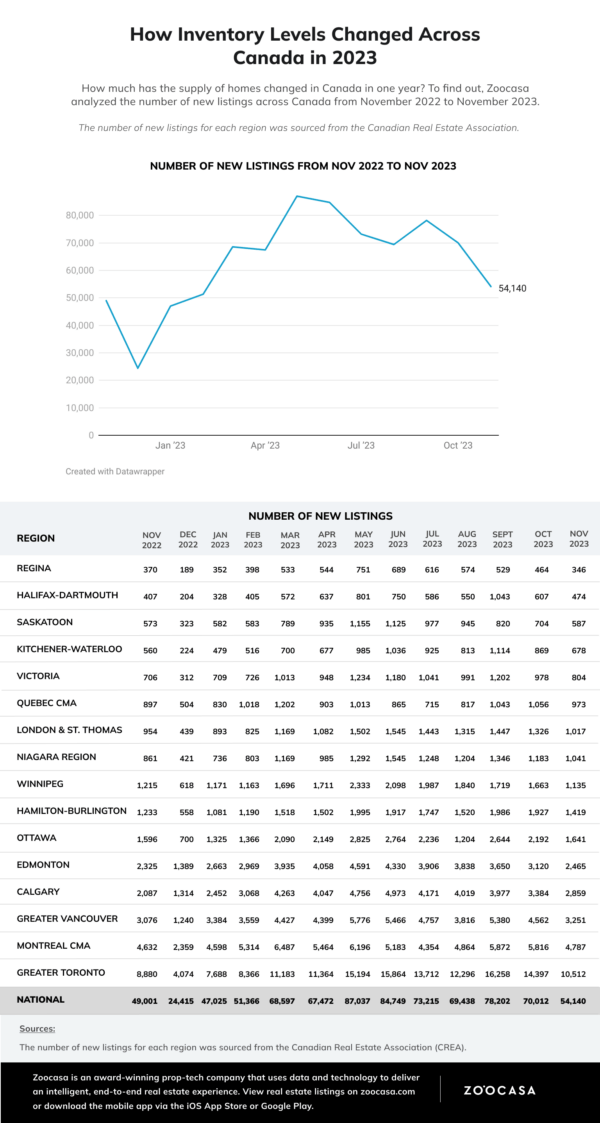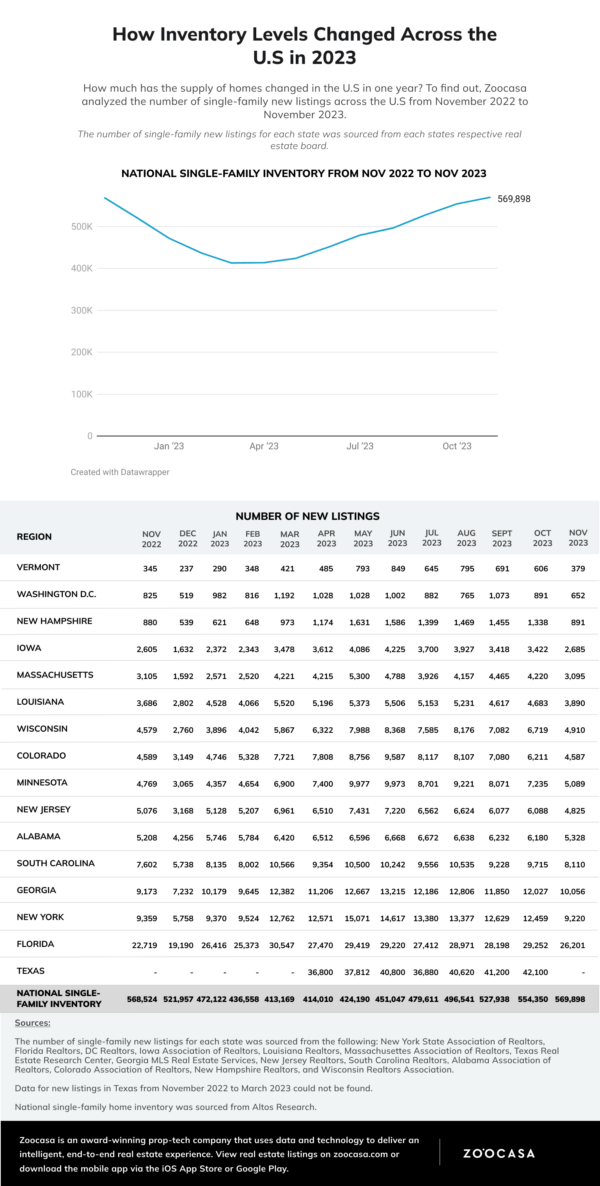In 2023, the North American housing market faced significant challenges due to a notable scarcity of listed homes. In part, this was created by high demand during the pandemic years of 2020 and 2021, when interest rates were at record lows, and prompted a fervor of real estate activity.
Interest rates have now climbed to more than triple what they were a few years ago, and though this has tampered buyer activity, it has allowed inventory to build in much of Canada and the U.S.
Enjoying our content? Subscribe to our free weekly newsletter to get real estate market insights, news, and reports straight to your inbox.
To find out exactly how inventory levels have changed over the course of a year, Zoocasa analyzed months of inventory and new listings data from November 2022 to November 2023 in Canada and the U.S. Months of inventory and new listings data for Canada was sourced from the Canadian Real Estate Association. Months of supply of single-family homes in the U.S. was sourced from the National Association of REALTORS®. National single-family inventory in the U.S. was sourced from Altos Research, while new listings data for U.S. states was sourced from each state’s real estate board.


New Listings Up Year-Over-Year In Nearly Every Canadian Market
On a national level, the number of new listings entering the market increased from 49,001 in November 2022 to 54,140 in November 2023 – an impressive 10.5% increase. The 2023 low for national new listings was in January when new listings sat at just 47,025, while new listings reached their 2023 peak in May with 87,037 new listings. This increase in new listings helped edge up national months of inventory, which increased almost every month from November 2022 to November 2023. In November 2022, there were just 2.8 months of inventory for the country but by November 2023 months of inventory increased to 3.6 months.
Six markets outperformed the national increase of 10.5% in new listings from 2022 to 2023, with standout growths including Kitchener-Waterloo at 21.1%, Niagara Region at 20.9%, and Greater Toronto at 18.4%. It’s not just new listings that have seen a surge in Toronto, but active listings too. A recent Zoocasa report that analyzed inventory growth in the Greater Toronto Area revealed that the City of Toronto experienced a 42% jump in active listings from November 2022 to November 2023.
Yet among the 16 markets we analyzed, Calgary experienced the largest growth in new listings, rising from 2,087 in November 2022 to 2,859 in November 2023. This represents a 37% year-over-year increase and is more than triple the national increase of 10.5%. Still, thanks to consistently strong sales, supply has yet to catch up with the ongoing demand in the region.
Only two markets we analyzed experienced a drop in new listings from 2022 to 2023, Winnipeg at -6.6% and Regina at -6.5%. While the majority of markets experienced an increase from their January 2023 lows, Regina and Winnipeg’s November figures hover slightly below, suggesting potentially tighter conditions in these markets.


Inventory Levels Show a Modest Rise in the U.S.
Nationally, single-family inventory experienced minimal gains, inching up from 568,524 single-family homes in November 2022 to 569,898 single-family homes in November 2023. That represents just a 0.2% increase, however, for much of 2023 single-family inventory was below 500,000 so this showcases an improvement. When looking at national months of inventory it is also clear that conditions are stabilizing. In November 2022, national months of inventory for the U.S. sat at 3.4 months and grew to 3.7 months by November 2023, just slightly above Canada.
From state to state, year-over-year growth in new listings varied. Of the 16 states we analyzed, Florida experienced the largest improvement in new listings, increasing by 15.3% from 2022 to 2023. This is a positive shift in conditions for buyers looking in high-demand markets, such as Miami and Tampa, and could lead to more balanced negotiations.
Other states that are showing encouraging improvements include Vermont with a 9.9% year-over-year increase and Georgia with a 9.6% year-over-year increase. Conversely, new listings in Washington D.C. and New Jersey were down significantly, with decreases of -21% and -4.9% respectively. These population-dense markets face increased difficulty in building up inventory because of higher demand and limited space.
If you’re looking to enter one of these markets, it’s important to speak with a local real estate agent who can give you specific information and guidance about the local real estate market. Give us a call today to discuss your home-buying plans.















